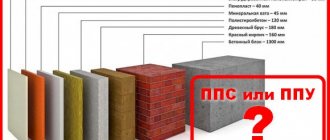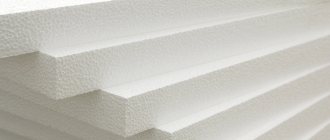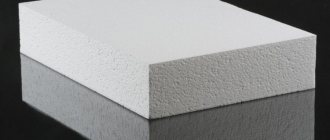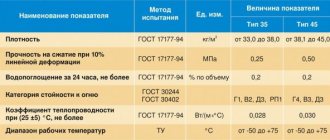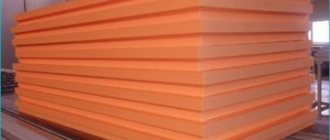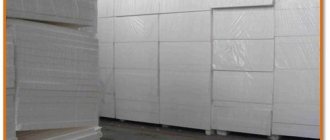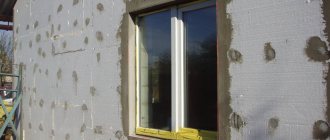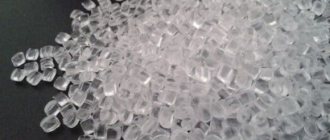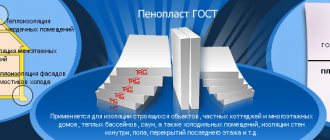Features of the material
Extruded polystyrene foam was created in the USA in the early 40s of the 20th century. It is a synthetic thermal insulation with unique properties, which were achieved through the use of special technologies during the production process.
Modern manufacturers have mastered the production of material of various colors and shapes: in the form of cylinders, rolls, slabs, segments. The cost of insulation depends on its dimensions, density and manufacturer.
Production
XPS is produced by extrusion. Polystyrene granules under the influence of high temperatures and pressure are mixed with a foaming agent in a special apparatus - an extruder. Then, using pulling rollers and pressure, the material is squeezed through a die, which helps give the material the desired shape.
Foaming of the mixture ends when it comes into contact with air. The next stages of manufacturing are cooling of the insulation and its stabilization. The production process is completed by cutting the thermal insulator into pieces of the established size and packaging it using thermal machines.
For comparison: in the production of conventional polystyrene (foam), granules of the material are steamed with water vapor until they significantly increase in size, until the mold intended for the insulator is completely filled.
Carbon dioxide, mixtures of light freons or freon-free systems based on CO2 can be used as foaming agents. It was the use of substances purified from freons that made it possible to bring the production of the material to a qualitatively new level, making it environmentally friendly and clean. The heat insulator coming out of the extruder has a uniform structure with closed pores and microcells ranging in size from 0.1 to 0.2 mm.
Technical specifications
XPS insulator has the following unique properties:
- vapor permeability coefficient – 0.004 mg/(m•h•Pa);
- thermal conductivity level – from 0.026 to 0.032 W/(m•K);
- moisture absorption in 24 hours – 0.3%;
- specific gravity – 25-45 kg/m3.
Characteristics of expanded polystyrene
The positive qualities of XPS insulation make it perhaps the best option among the entire range of thermal insulation materials on the market:
- Extruded polystyrene foam is characterized by minimal hygroscopicity;
- Has low conductivity of heat and steam;
- Does not absorb moisture;
- Resistant to fire;
- Thanks to its structure, XPS has unusually high compressive strength and biological stability (that is, it does not harbor insects and rodents);
- This is an environmentally friendly and safe material;
- It is impossible not to note the simplicity and ease of installation - all work on thermal insulation can be done with your own hands, without assistants;
- Expanded polystyrene is not the cheapest insulation material, but its price is quite reasonable. Of course, it is a little higher than, for example, mineral wool or ordinary polystyrene foam, but the costs will be doubled. We'll talk about this a little later.
Expanded polystyrene in the form of mats of various thicknesses
Reliable thermal insulation of residential, municipal and industrial buildings plays a major role in reducing heating costs. And, as you have already noticed, extruded polystyrene foam is quite capable of providing effective insulation - with its help you can get rid of heat loss for a long time and save a lot of money on your budget.
Note! XPS expanded polystyrene can be used to insulate loggias, walls, floors, foundations, roofs, communications, garages, and many other structures.
Balcony insulation with XPS slabs
Material advantages
Extruded insulation has a lot of attractive characteristics for the consumer.
Durability and reliability
XPS is characterized by increased resistance to various deformations. It can be bent, compressed or stretched - this will not in any way affect the reduction in its quality characteristics.
The unique strength of the insulation allows it to withstand even a 50-ton load applied to 1 m2, which is explained by the strong bond between the molecules of the material.
Waterproof
The insulation is considered quite durable due to its immunity to moisture absorption (expanded polystyrene boards have zero capillarity). This property is not affected even by the proximity of groundwater and moist soil. Only the outer shells of the material are filled with moisture, and its core is reliably protected.
Non-flammability
The fire safety of the material has been experimentally confirmed and is explained by the addition of fire retardants (substances that prevent fire) during the production process, which have increased efficiency.
According to modern classification, XPS can have different flammability classes: from the weakest - G1, to G4. However, even a material with a high flammability rating does not support the spread of fire and will die out within a short period of time if there is no open flame nearby.
It is important to understand that extruded polystyrene foam can only ignite when exposed to very high temperatures, and at low temperatures it simply melts and does not pose any particular threat.
Considering the fact that most fire deaths occur as a result of carbon monoxide poisoning or vapors of harmful chemical compounds, the low level of toxicity of XPS plays an important role. In the event of smoldering or fire, this insulator practically does not emit harmful substances into the atmosphere.
Optimal thermal conductivity
The thermal conductivity of a material depends on how much air it contains: the more air there is, the higher the thermal insulation characteristics. Extruded insulation consists of 10% polymer and 90% air, which is due to the foaming process.
For comparison, a 20mm thick extruded polystyrene foam board has the same level of thermal conductivity as a 30mm piece of polystyrene foam, a 200mm thick timber board, 370mm thick brickwork or about 40cm thick mineral wool.
Other advantages
There are several more significant advantages of insulation:
- XPS isolator can be frozen and refrozen 500 to 1000 times. At the same time, it will not change its quality characteristics for the worse, and the thermal resistance of the material will not exceed 5%.
- Expanded polystyrene is insensitive to alkalis, acids and mineral fertilizers, and does not react in any way to contact with soap, soda, gypsum, bitumen, asphalt or cement.
- The insulation has high biological stability. This means that the material does not at all attract insects, harmful rodents, and is not afraid of mold and other microorganisms.
- The material is resistant to climatic and temperature changes and can be used in the range from -75 to +75 degrees. It also practically does not deteriorate under the influence of active ultraviolet radiation, which cannot be said about polystyrene foam.
Main characteristics and properties
Houses or apartments insulated with xps polystyrene can reduce costs during the heating season and improve the thermal insulation of the room, preventing the appearance of dampness and mold on the walls.
Color
Silver polystyrene foam with carbon has higher thermal insulation properties.
In technical documentation, the standard color for polystyrene foam boards is white.
But if for insulating a house it is necessary to choose a material with higher thermal conductivity properties, preference should be given to silver insulation boards, which contain nanographite, which is responsible for improving the qualities of the material.
Complete information about extruded polystyrene foam
Extruded polystyrene foam, what is it? Extruded polystyrene foam is a synthetic material for thermal insulation, developed by an American construction company in the 50s of the twentieth century. Manufactured using foaming technology, the composition uses polymer compositions. The material is pressed through a special mold and joined into a single piece.
Available in the form of slabs and substrates. Found on the market as a decorative element. The standard size of the slabs is 600x1200 or 600x2400 mm. Standard sizes are established by GOSTs, but many companies change the sizes, making plates of different widths. The common size is 580 mm. The thickness of the elements varies from 20 mm to 10 cm, depending on the manufacturer.
The material is delivered to retail outlets in packages of several elements. The number of units in one package depends on the thickness of the products. For example, if the thickness of the slabs is 5 cm, the package usually contains 8 units of goods. With a thickness of 10 cm, 4 plates are packed.
Additional information: it is possible to produce expanded polystyrene as a floor covering. The modern market offers materials for laminate, parquet, and linoleum. It is possible to manufacture decorative elements based on the material. They look exactly like plaster.
Advantages and disadvantages
Like any other material, extruded polystyrene foam has advantages and some disadvantages. It is worth familiarizing yourself with them before purchasing and using them.
Advantages of extruded polystyrene foam:
- Moisture absorption within 0.2%. This indicator means almost complete waterproofness.
- Minimum thermal conductivity. At a standard temperature of 25°C it is about 0.032 W/m*K. If we compare the heat conductivity, the indicators are as follows: 55 cm of brick equals 3 cm of polystyrene foam.
- Withstands deformation well. Can be used for laying under a blind area, or after the foundation.
- Does not react with inorganic chemical reagents.
- Withstands significant temperature changes, the indicators do not change at air temperatures from -50 to +75°C.
- According to the documentation, the material can be used for at least half a century. During this time, the characteristics will not change.
- Environmentally friendly substance. It is used not only as insulation, but, for example, for the production of lightweight disposable plates or other types of cheap tableware. Children's toys are made from it.
- Has minimal weight. A small thickness is enough for good insulation.
In addition to numerous positive characteristics, some disadvantages can be identified:
- comparison with other types of insulation shows that the price of the material is high;
- highly flammable. During the combustion process, harmful substances and black smoke are released;
- destroyed under the influence of infrared rays. To maintain performance characteristics, it must be hidden from direct sunlight;
- Manufacturers assure that rodents will not grow inside the insulation. Indeed, they do not live inside, but often make channels for movement;
- solvents destroy the structure.
In addition to the listed disadvantages, low vapor permeability can be added to them. Sometimes this is a plus, but if you insulate a wooden house, fungi and mold may develop. As a result, an unpleasant odor appears in the home and dampness is constantly felt.
Application area
Extruded gray polystyrene foam has a wide range of applications. Mainly used for insulation work. The scope of use is limited only by temperature indicators (not higher than 75°C). The material can be laid in damp places, in the ground.
Typically, the scope of use is limited only by financial capabilities. The high cost makes it impractical for use in many places. In places where there is no need for high technical characteristics, ordinary polystyrene foam is used instead of PPS, reviews of which are also positive, in order to save money.
Used for insulation:
- concrete or wooden floors;
- walls indoors or outside the building. Compatible with any material;
- wells. Often concrete rings are coated with material for additional protection;
- blind areas;
- surface of the earth. To prevent destruction of the structure, paint is applied. Even a thin layer will not allow the composition to deteriorate.
In addition to the listed areas, the material is used in road construction. Included in many refrigeration units as extruded insulation. Used in agriculture. Roofs and underground floors are insulated with expanded polystyrene. One of the promising areas is the production of sandwich panels.
Technical characteristics of extruded polystyrene foam
The material has some of the highest technical characteristics on the market of insulation products. Any gas has a much lower thermal conductivity than solids. For air, the figure is 0.026 W/m*oC. Extruded polystyrene foam is an air mixture of approximately 90%. It has a thermal conductivity of 0.03 W/m*oC. Almost like air, which means heat is retained perfectly.
The material is produced with different densities. Manufacturers offer from 25 to 47 kg/m3. The higher the number, the greater the strength. As the density increases, the strength increases from 20,000 to 50,000 kg/m2.
Water is poorly absorbed by polystyrene foam. In about a month, one tile can absorb about 0.4% of its own volume if it is completely immersed in water. Further, the percentage of absorbed liquid does not increase, but stops. Vapor permeability is minimal. It is 0.0128 Mg/(m*h*Pa). Often companies specializing in repair work suggest not using vapor barriers, limiting themselves to using only polystyrene.
The insulation is able to withstand temperatures ranging from -50 to +75°C. Its use is possible in almost any climate. The flammability is high, the class varies depending on the addition of additional substances, from G1 to G4.
Some models have a special recess along the edges. Made to increase the tightness of the slabs by insulating the seams. This innovation prevents cold layers from forming between the elements, ensuring complete heat retention.
Tests were carried out with polystyrene foam. Their meaning is repeated freezing and thawing of wet tiles. It was determined experimentally that the material can withstand 80 cycles without changing the technical characteristics. This information is useful for users: the composition can withstand approximately this number of years during operation.
Additional information: compared to polystyrene foam, polystyrene foam is approximately 2 times superior in heat retention. Increased strength, reduced thickness. Compared to other insulation materials, sound permeability is not very high. The disadvantage is compensated by ease of installation. Completely safe for health.
Material selection rules
The demand for expanded polystyrene is high and increases every year. In order for the insulation to last as long as possible and perform all the required functions without failures, you need to make the right purchase. Every manufacturer claims that their product is the best on the market, but this is not always true.
Selection rules:
- Polystyrene is designated by two numbers. If the marking is below index 28, you should refuse to purchase. Checking is mandatory; some brands of products are not suitable for façade work and will not cope with the insulation of a house. Choose material with an index of 40 and above. The PSB-S-40 brand, a self-extinguishing composition, has proven itself well.
- Before purchasing, look at the standards on which production was carried out. Many manufacturers produce slabs not according to GOSTs, but to their own specifications. Possible poor quality product. Usually the density is reduced, thereby reducing the cost. You should not rely on the brand number; be sure to familiarize yourself with the characteristics.
- To ensure the high quality of the product, you can break off a small piece from the edge. If small balls are visible at the fracture site, the polystyrene foam is probably low-grade. There should be polyhedra of the correct shape at the fracture. The broken piece is straight. The test shows the production method: extrusion performed on professional equipment, or a homemade method, like simple polystyrene foam.
- Purchase goods from reputable manufacturers. These are “Penoplex” URSA, Knauf and “Technonikol” - Russian. "Basf" or "Novachemicals" are foreign.
Do not forget that the production of polystyrene foam is a complex technological process. Production methods differ among many manufacturers. Some are safe, others can harm human health.
Manufacturer brands
Each brand of polystyrene foam manufacturer differs from competitors in some features. To understand the variety of choices offered, it is worth considering the products of each manufacturer in more detail.
Knauf
Manufacturer from Germany. Production is represented by numerous variants of polystyrene foam.
Insulation materials used:
- Knauf Therm Compack. Universal, used for any type of household thermal insulation. It has a low thermal conductivity coefficient of 0.032 W/μ, high sound insulation properties. The airborne noise reduction index is 47 dB, impact noise is damped if the indicator does not exceed 24 dB. Due to its performance, it is well suited for insulating small rooms.
Might be interesting
Thermal insulation
How to insulate a roof from the inside and not make mistakes?
Thermal insulation
Roofing and drainage: heating rules
Thermal insulation
Insulated Swedish stove: pros and cons
Thermal insulation
Penoizol: self-production
Supplied in slabs 1 x 0.6 m long. Thickness 5 cm. Vapor permeability 0.033 mg/mhPa
- Knauf Therm Roof Light. The density is low, 10–15 kg/m³. used to retain heat on the rafter frames of houses. Characteristics: heat conductivity 0.034 W/μ, steam conductivity – 0.035 W/μ.
- Knauf Therm Wall - for wall insulation. The indicators are the same as previous designs, with increased mechanical strength. 60 kPa is an indicator of compressive strength. The choice of slab sizes is wide. Thermal conductivity: 0.033 W/mk, vapor conductivity: 0.032 mg/mhPa. G3 – flammability class.
There are models Knauf Therm Flor, suitable for floor insulation, with a low thermal conductivity of 0.03 W/μ and Knauf Therm 5 in 1. The latter stands out for its maximum strength among all the company’s models. Withstands up to 17 t/m2.
URSA
The Russian polystyrene foam manufacturer URSA presents several product options.
| Model/Specifications | URSA XPS N-III | URSA XPS N-III-G4 | URSA XPS NV |
| Thermal conductivity | 0.032 W/mK | 0.032 W/mK | 0.033 W/mK |
| Application temperature | from -50 to +75 | from -50 to +75 | from -50 to +75 |
| Water absorption | 0.3% of volume in 24 hours | 0.3% of volume in 24 hours | 0.3% of volume in 24 hours |
| Vapor permeability coefficient | 0.004 mg/mhPa | 0.004 mg/mhPa | 0.004 mg/mhPa |
| Compressive strength | 25 t/m² | 25 t/m² | 50 t/m² |
The products differ from other manufacturers in their increased strength. The material is indispensable for professional construction. One of the most durable options that can withstand significant loads.
Penoplex
Domestic manufacturer of expanded polystyrene. Has a wide range of models. Plates can be used for various insulation options.
The following types of products are distinguished:
- Penoplex Wall
| Characteristics | Meaning |
| Thermal conductivity | 0.03 W/(m×°K) |
| Density | 25.0-32.0 kg/m³ |
| Compressive strength | 0.20 MPa |
| Water absorption | 0,5% |
| Fire resistance | G3 |
| Temperature range | -50 … +75 °С |
- Penoplex Foundation
| Characteristics | Meaning |
| Thermal conductivity | 0.03 W/(m×°K) |
| Density | 29.0-33.0 kg/m³ |
| Compressive strength | 0.27 MPa |
| Water absorption | 0,5% |
| Fire resistance | G4 |
| Temperature range | -50 … +75 °С |
- Penoplex Roofing
| Characteristics | Meaning |
| Thermal conductivity | 0.03 W/(m×°K) |
| Density | 28.0-33.0 kg/m³ |
| Compressive strength | 0.25 MPa |
| Water absorption | 0,5% |
| Fire resistance | G3 |
| Temperature range | -50 … +75 °С |
- Penoplex Comfort
| Characteristics | Meaning |
| Thermal conductivity | 0.03 W/(m×°K) |
| Density | 25.0-35.0 kg/m³ |
| Compressive strength | 0.20 MPa |
| Water absorption | 0,5% |
| Fire resistance | G4 |
| Temperature range | -50 … +75 °С |
- Penoplex 45
| Characteristics | Meaning |
| Thermal conductivity | 0.03 W/(m×°K) |
| Density | 35.0-47.0 kg/m³ |
| Compressive strength | 0.5 MPa |
| Water absorption | 0,4% |
| Fire resistance | G4 |
| Temperature range | -50 … +75 °С |
TechnoNIKOL
Considered a leader in the field of insulating materials. Every year the volume of production increased rapidly. Now insulation products are a little more expensive than competitors on the Russian market, but the quality of the product is the highest. Specializes in the production of numerous types of various insulation materials. Expanded polystyrene is available in several models.
| Specifications/Model | Technoplex | Carbon Eco | XPS 35-300 | Prof | |
| Thermal conductivity | 0.032 W/μ | 0.029 W/μ | 0.028 W/μ | 0.028 W/μ | |
| Density | from 26 to 35 kg/m³ | 26-32 kg/m³ | 35 kg/m³ | 30 kg/m³ | |
| Compressive strength | 200 kPa | 250 kPa | 400 Kpa | 300 kPa | |
| Water absorption | 0.2% | 0.2% | 0.2% | 0.2% | |
| Fire resistance | G4 | G4 | G4 | G4 | |
| Temperature range | -50 … +75 °С | -50 … +75 °С | -50 … +75 °С | -50 … +75 °С | |
| Vapor permeability | 0.01 mg/mhPa | 0.011 mg/mhPa | 0.01 mg/mhPa | 0.01 mg/mhPa | |
FAQ
– What is better for a screed, expanded clay or expanded polystyrene?
The thermal conductivity coefficient of expanded clay is on average 0.12, and that of penoplex is 0.03 W/m*C. Those. almost an order of magnitude. Thus, to ensure the required thermal insulation of floors, the backfill of cermatite will be much thicker than laying sheets of Penoplex and the like. And as a result, the entire structure of floors with expanded clay will be much thicker than the structure of floors with penoplex.
– Polyurethane foam or polystyrene foam, which is better?
Having carried out a comparative analysis of both insulation materials, we can say the following: polyurethane foam has higher characteristics in terms of noise insulation, moisture resistance, and heat resistance. Has a higher fire safety class. However, its thermal conductivity is an order of magnitude lower.
Considering that we are talking about choosing a material for insulation, polystyrene foam will be the best. Although, given the experience of users, there is no need to use a material with such high performance as polystyrene. Therefore, preference when purchasing should be given to polyurethane foam.
– Is polystyrene foam harmful to human health?
No, the material is completely safe to use. The only problem is that when burning, acrid smoke is released.
– What surfaces cannot be insulated with polystyrene foam?
You cannot insulate surfaces whose temperature exceeds the specified limits: -50 ... +75 °C. Another limitation: in wooden houses where good vapor barrier is required, it is not advisable to use the material. Mold and mildew may form between the wall and the insulation. No humid air will escape from the house. There will be constant high humidity in the room.
What is extruded polystyrene foam? Universal insulation. It is considered one of the modern examples of materials of this class. When using it, you must comply with the established temperature standards and other important requirements. If EPS insulation is done correctly, manufacturers provide a guarantee for the service life of polystyrene for at least 50 years.
Areas of application of extruded polystyrene foam
Thermal insulation has a wide range of applications. The high strength characteristics of insulation are its main advantage and allow it to be used not only as a material for thermal insulation, but also as a building material.
Insulation of the apartment
- Balcony insulation
- Creating a “warm floor”
- Thermal insulation of walls
- Insulation of floors
Insulation of a private house/cottage
- Foundation insulation
- Insulation of the base and blind area
- Insulation of indoor walls (including balconies)
- Insulation of pitched roofs
- Insulation of floors of interfloor ceilings and the first floor
- Creating a “warm floor”
- Insulation of flat roofs of low-rise buildings, cottages
Insulation in industrial and civil construction
- Thermal insulation of the foundations of multi-storey buildings and other civil and industrial facilities
- Thermal insulation of flat roofs of multi-storey buildings and other civil or industrial facilities
- Thermal insulation of facades and plinths
- Thermal insulation of loaded floors with increased requirements for the strength of the thermal insulation layer
- Stylobate structures
Insulation of roads and bridges
- Thermal insulation of the bases of transport structures
- Thermal insulation of the foundations of railway structures
- As expansion joints in concrete or to protect waterproofing (on railway bridges)
- Thermal insulation device to prevent thawing of permafrost soils
Types and general characteristics of extruded polystyrene XPS TECHNONICOL
XPS TECHNONICOL CARBON ECOCARBON ECO is the optimal material for creating effective thermal insulation in a country house. Strong, reliable, durable thermal insulation that does not absorb water and is not subject to rotting. The slabs retain their original volume throughout their entire service life. |
XPS TECHNONICOL CARBON PROFCARBON PROF – designed specifically for professional use. Combines low density and exceptional strength. It is especially in demand when arranging objects with a flat roof (residential buildings, warehouses, office and shopping centers), as well as when insulating foundations and floors. This product line offers XPS CARBON PROF SLOPE insulation, designed to form a slope on a flat roof. |
XPS TECHNONICOL CARBON SOLIDCARBON SOLID – used in the construction of residential, industrial, and transport facilities. Provides high-quality insulation of foundations and interfloor slabs of buildings, as well as engineering transport communications (roads and railways, aviation runways). |
XPS TECHNONICOL CARBON ECO SPCARBON ECO SP is widely used in construction when installing “insulated Swedish slabs”. It simultaneously houses thermal insulation materials and utilities: elements of water supply, sewerage, floor heating, etc. This is a very effective and economical construction solution. |
XPS TECHNONICOL CARBON ECO DRAINCARBON ECO DRAIN - optimal for use in cases where it is necessary to provide additional insulation of the foundation simultaneously with the creation of a wall drainage system. It can also be used in flat roof structures to improve the quality of ventilation and more intensive drainage. |
XPS TECHNONICOL CARBON ECO FAS RFXPS CARBON ECO FAS RF insulation – the milled surface ensures a high level of material adhesion, thanks to special microgrooves. It is used for insulation of façade and basement structures, as well as other elements of buildings and structures that require the most durable adhesion of the thermal insulation layer to the base. |
XPS TECHNONICOL CARBON PROF SLOPE RFXPS TECHNONICOL CARBON PROF SLOPE RF insulation - a unique set of wedge-shaped slabs allows you to form the necessary slopes (including on a flat base) or increase the angle of the existing slope. Also used to adjust the direction of drainage during roof repairs and reconstruction. Allows you to change the level of slope in areas of valleys, ventilation outlets, skylights, fences, etc. |
XPS TECHNONICOL CARBON SANDCARBON SAND - this type of polystyrene foam insulation is produced specifically for creating combined sandwich panels. Used as a universal base for multilayer thermal insulation boards manufactured by various manufacturers. |
Minuses
Despite all the advantages of the unique insulation, it is necessary to pay attention to its disadvantages. Caution should be exercised when XPS comes into contact with certain types of varnish, acetone or drying oil. These substances can not only damage the surface of the insulator, but also completely dissolve it.
Also, the insulation is easily susceptible to the influence of products obtained through the distillation of petroleum and the influence of some alcohols. That is why you should pay special attention to the composition of the adhesive mixtures with which you plan to attach the insulator. It is important that they do not contain ethyl acetate, petroleum toluene, coal tar or its derivatives.
During prolonged use in air, extruded polystyrene foam undergoes oxidation, although modern industry is gradually reducing all negative aspects to a minimum.
Range
On the building materials market you can find polystyrene thermal insulator XPS from different manufacturers. The most popular products are Ursa, an American brand Dow.
TechnoNIKOL offers a fairly wide range of extruded polystyrene foam. This includes Technoplex slabs used to insulate balconies, loggias, partitions, as well as a large number of different insulation products from the Carbon line. The Carbon series includes materials intended for professional builders (Prof), for insulating private houses and cottages (Eco), for thermal insulation of roads, floors with high loads (Solid), and also used as the main layer in various thermal insulation panels (Sand) .
